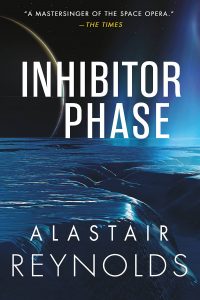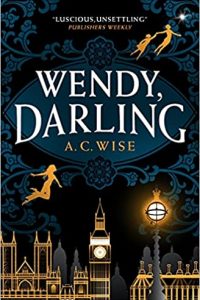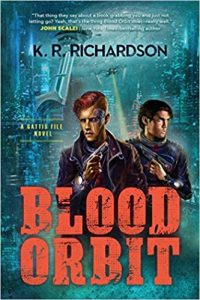Graham Sleight’s Yesterday’s Tomorrows: Theodore Sturgeon
There’s no more personal aspect of anyone’s responses to stories than their response to emotion. Theodore Sturgeon’s work makes the most direct appeals possible to the reader’s emotions. So, even more than usual, this is a case where my own views on a writer may not tally with yours. When I say, though, that I often find Theodore Sturgeon’s stories enormously affecting, I’m far from the only one to feel that. If Sturgeon is valued for any one thing in the SF community, it’s for finding ways to tell stories that reach out emotionally beyond the props and tropes of the genre.
Sturgeon’s first novel, The Dreaming Jewels, embodies his peculiar combination of directness and artfulness. It follows Horton (‘‘Horty’’) Bluett, a young orphan adopted by a callous politician. After Horty commits a trifling infraction at school, his adoptive father beats him and Horty runs away. Soon enough, he falls in with the denizens of a traveling carnival, who provide him with a kind of home. The fantastic element is provided by a toy he takes with him, ‘‘Junky,’’ whose crystal eyes seem to carry some sort of supernatural power. The novel explores the nature of that power, and what it might be worth for people who want to exploit it.
This is an abiding theme for Sturgeon: someone rejected – or at least not conventionally understood – by society has out of their loneliness created or discovered something of immense value. The question that arises then is how to use it ethically. That’s certainly where The Dreaming Jewels ends up, but the material that sticks in the memory is from earlier in the book, from its acute and intense rendering of Horty’s aloneness. Here’s a section from the first chapter, where he’s on the point of running away from his monstrous adoptive father Armand:
None of this was really his. If there had been a smaller room, he would have been shoved into it. There were two guest bedrooms on this floor, and another above, and they almost never had guests. The clothes he wore weren’t his; they were concessions to something Armand had called ‘‘my position in this town’’; rags would have done if it weren’t for that.
He rose, the act making him conscious of the clutter he still clutched in his arms. He put it down on the bed. The mitt was his, though. He’d bought it for seventy-five cents from the Salvation Army store. He got the money by hanging around Dempledorff’s market and carrying packages for people, a dime a trip. He had thought Armand would be pleased; he was always talking about resourcefulness and earning ability. But he had forbidden Horty ever to do that again. ‘‘My god! People will think we are paupers.’’ So the mitt was all he had to show for the episode.
Many readers today will be reminded of another orphan with special powers who gets shoved into a tiny room, Harry Potter. But look at how subtly Sturgeon lays down information about Horty’s perception of the world. Although the passage (and the book) is in the third person, it’s very closely tied to his perceptions. So he has registered, for instance, that Armand could have given him one of the larger rooms but has chosen not to. He’s not, however, sufficiently steeped in the ways of the world to realise what Armand means by his ‘‘position in the town.’’ The story about the mitt is the kind of thing that teeters on the edge of pathos and sentimentality; for me at least, the clinching reason why it works is the knowledge that it’s not fantastic: that then and now there are children in prosperous countries with this little in love or possessions.
The carnival folk with whom Horty falls in are straight out of Ray Bradbury (and indeed one of them later encourages Horty to read a selection of books including The Martian Chronicles.) The bulk of the book is devoted to Horty’s growing up in this strange environment. Part of its point – not delivered too didactically – is that unorthodox family setups like this can be better than ones with more conventional respectability. What matters is how loving they are. Sturgeon has a fondness and a talent for depicting the scenery and emotional contours of certain unglamorous bits of American life: cramped apartments, worn-down diners, smart people trapped in dumb jobs. Indeed, the part of The Dreaming Jewels that seems most run-of-the mill is the jewels themselves, and the pseudo-magic powers they carry. Sturgeon famously defined a good science fiction story as one that could not happen without its science content. That may be true of The Dreaming Jewels, but the fantastic content in it is far from the most deeply-felt.
In retrospect, The Dreaming Jewels seems like a dry-run for More Than Human, Sturgeon’s most well-known novel. It’s composed of three novellas of which the second, ‘‘Baby Is Three’’ was published separately in Galaxy. ‘‘Baby Is Three’’ describes a fantastic situation; the first novella, ‘‘The Fabulous Idiot’’, describes how it arose. The idiot of the title is a man called Lone, seemingly incapable of communication, who wanders through the countryside until he experiences a moment of fleeting connection with a girl called Evelyn. But Evelyn’s father – another of the monstrous preventers-of-feeling like Armand in The Dreaming Jewels – finds this repugnant, and kills Evelyn and wounds Lone before shooting himself. But the pattern is set: a number of people with seemingly unusual or abnormal activities come together to form a kind of collective organism. They include Lone, as well as a pair of twins with psychokinetic abilities and a baby who seems to have remarkable calculating activities. They secret themselves away from society and begin to grow together. But the new creature – homo gestalt – lacks an ethical sense. Although it can create and accomplish remarkable things, it lacks an idea of what right and wrong are. ‘‘Baby Is Three’’ focuses on one member of the gestalt, another outcast boy, called Gerry. He goes to see a psychiatrist called Stern to talk through the history of the gestalt and his place in it. It’s clear that Gerry is interested in worldly things – he gets Stern’s attention by slapping a thousand-dollar bill on the desk – and that he’s found his encounter with the gestalt both entrancing and traumatic. The bulk of the therapy session with Stern is devoted to unpicking why the phrase ‘‘Baby Is Three’’ carries an unendurable weight of shock with it. Stern eventually manages to unpick what happened to Gerry, and Gerry then exercises his own gestalt-derived powers to wipe Stern’s memory. It’s clear that he could, if he wished, co-opt the gestalt to serve his interests only.
As ‘‘Baby Is Three’’ ends, Gerry asks ‘‘What the hell is morality, anyway?’’ The final section is, inevitably, called ‘‘Morality’’, and at its heart is a confrontation between Gerry and another outcast boy called Hip. Hip makes an argument to Gerry based on definitions offered earlier on: morality is society’s code for an individual’s survival, and ethics are an individual’s code for society’s survival. Because the Gerry-led gestalt would be a one-of-a-kind, without a wider society, morality would not be useful to it. But ethics would, according to Hip:
The ethos will give you a code for survival too. But it is a greater survival than your own, or my species, or yours. What it is really is a reverence for your sources and your posterity…
And when there are enough of your kind, your ethics will be their morals. And when their morals no longer suit their species, you or another ethical being will create new ones that vault still farther up the main stream, reverencing you, reverencing those who bore you and the ones who bore them, back and back to the first wild creature who was different because his heart leapt when he saw a star.
In the context of the story, this is effective and affecting rhetoric – and, indeed, it works on Gerry. It also makes visible another Sturgeon trait: the autodidact’s need to create new conceptual systems from the ground up. Again and again in his stories, he finds a way of structuring thought that seems entirely new, created from whole cloth. Sometimes, those thoughts are scientific speculation; sometimes, they’re theories about more abstract or subjective questions. What makes More Than Human so successful is that it integrates that speculation into an affecting emotional story. This is leaving aside another subject that could be the subject of an entirely separate essay: Sturgeon’s love of language and skill as a stylist. The default for SF in the 1950s – and still now to an extent – is a kind of journalistic directness. Sturgeon skewed away from this and, as the extracts I’ve quoted suggest, he always skewed towards amplifying emotion. One could break this down into rhetorical devices, like the repeated use of ‘‘reverencing’’ in the quotation above, or the way that last long sentence starts out with longer, abstract words and slowly unwinds its energy till it lands on the monosyllables of ‘‘his heart leapt when he saw a star’’. Better to say simply that More Than Human is the novel where Sturgeon got everything right: his abiding concerns, the language he used to express them, an intricate plot to expound all this, and a kind of charisma-of-argument that he aspired to throughout his career.
Venus Plus X is rather different. It’s partly a utopia, and partly a debate about men’s and women’s changing roles in Western society. A man named Charlie Johns wakes up in a strange, futuristic place. He has memories of living in the 20th century, but finds that he is now in a place called Ledom, many years afterwards. The most striking thing about Ledom is that inhabitants seem, initially at least, to be all male. However, Charlie soon sees that one of them appears to be pregnant. This is a world where, at least in theory, the difference between the sexes has been made obsolete. Charlie’s exploration of Ledom (‘‘Model’’ backwards) sits in the tradition of many SF depictions of strange societies: a transparent ‘‘everyman’’ is allowed to ask the questions anyone would ask. In the end, some questions are answered (such as how Charlie got to Ledom), and some are unanswered.
Charlie’s narrative is interspersed with vignettes from the world he remembers, which argue – not too subtly – that even in his time, the gap between men and women is becoming less pronounced. Venus Plus X doesn’t wish away either love or sex, but like every story Sturgeon ever wrote, one feels it aspiring. It says that the place where Charlie comes from could be better. Each reader will have to decide whether Ledom is an end they can pledge allegiance to.
There are two problems with Venus Plus X for the contemporary reader. The first is that, even if one’s not schooled in academic writing about the field, it’s clear that the debate about men and women has moved on. Moreover, it now reads peculiarly as if directed at men. The choice of a male viewpoint character is part of the issue here, and certain things follow from that (such as Charlie perceiving Ledom’s inhabitants as men). You find yourself thinking how much more interesting a book it’d be if a woman from the same time were our eyes and ears.
So Venus Plus X is very much organised round a particular issue, and it’s discussion of that issue that allows Sturgeon to maintain its structure. Except in More Than Human, he always had some problems with maintaining narratives over the course of a novel. Sturgeon was, though, only intermittently a novelist. His career was defined far more by his short fiction, which he began publishing in 1939, and which continued almost to his death in 1985. North Atlantic Books are just now finishing their mammoth task of publishing his Collected Stories in 13 volumes (edited by Paul Williams and Noel Sturgeon), but for the reader new to his work, the obvious place to start is the Vintage Selected Stories.
Any Sturgeon fan might disagree with what’s in the Vintage volume – and indeed several did when I posted about it on the Locus blog – but there are plenty of unarguable inclusions. ‘‘The Man Who Lost The Sea’’, for instance, is a fractured reconstruction of a life, memory associating to memory in seemingly random sequence. For me at least it’s strongly reminiscent of later James Tiptree stories like ‘‘The Last Flight of Dr Ain’’ or ‘‘The Man Who Walked Home’’ – not just because death is the inevitable ending, but because of the way that the stories’ dense language is mirrored in a dense structure. These are works where finding out what’s happening, and discovering what all the fragments add up to, is as much a challenge for the reader as the narrator. ‘‘Bright Segment’’, on the other hand, is a straightforwardly told horror tale. If Sturgeon’s central subject is love, or how human beings can become more connected and less solitary, that shouldn’t suggest he was blindly optimistic about such things. ‘‘Bright Segment’’ is an economical and brutal tale of love gone wrong, of love inappropriate to the loved.
There are some stories here that seem rather dated now, particularly ‘‘Killdozer!’’ and ‘‘It’’, which read like relatively standard SF-magazine tropes gilded with Sturgeon’s particular gifts for language and character. Works like ‘‘A Way of Thinking’’ and ‘‘The Sex Opposite’’ feel far closer to the Sturgeon heartland. Both propose models, as it were, for how humans can become closer and more intimate. Sometimes in Sturgeon, the model is sexual (although not always stated as such), and sometimes it’s not, as with the Homo Gestalt in More Than Human. The crucial thing is to work out what’s the right – the ethical – kind of intimacy. For me at least this is most directly depicted in a story not contained in the Vintage book, ‘‘A Saucer of Loneliness’’, which puts in definitive form the dream of finding that kind of connection despite the impersonality of the world.
Finally, there’s ‘‘Slow Sculpture’’, a late story featuring yet another of Sturgeon’s solitary geniuses. In this case, he’s a lonely inventor who encounters a woman who’s discovered she has breast cancer. ‘‘Come up to the house and I’ll fix it,’’ he says. And he does, through an only partly-explained static electricity contraption. Sturgeon clearly has great fun coming up with a rationale for this couched in terms of the charges on atoms. But, in a kind of reversal of The Dreaming Jewels, the emotional story emerges and trumps the fantastic one. The man, it transpires, is not just an inventor but a kind of exile. The devices he’s created would, it’s clear, revolutionise human society. However, a gadget he’s created to strip out air pollution from internal combustion engines has made him millions – not because it’s being used, but because the oil companies have paid for it not to be used. So he’s become, as the story makes clear, a kind of bonsai tree, twisted into a weird gnarled shape by the world he’s found himself in. But so, it’s clear, has the woman; the prospect the story holds out is that this moment of recognition might present them with a chance for a life together. In Sturgeon, there is nothing better to wish for.












Pingback:Tweets that mention Locus Online Reviews » Graham Sleight’s Yesterday’s Tomorrows: Theodore Sturgeon -- Topsy.com
Pingback:Graham Sleight’s Yesterday’s Tomorrows: Theodore Sturgeon « Golden Age Of Sci-Fi
Pingback:Link Plenty « Torque Control
Pingback:The Great Geek Manual » Geek Media Round-Up: August 24, 2010
Pingback:Geek Media Round-Up: August 25, 2010 – Grasping for the Wind
Pingback:Sturgeon’s Law « Phil Ebersole's Blog
Pingback:Co tam w fantastyce słychać? (23 – 29 VIII 2010) | Zaginiona Biblioteka
Pingback:Graham Sleight’s Yesterday’s Tomorrows: Theodore Sturgeon « The Golden Age Of Sci-Fi